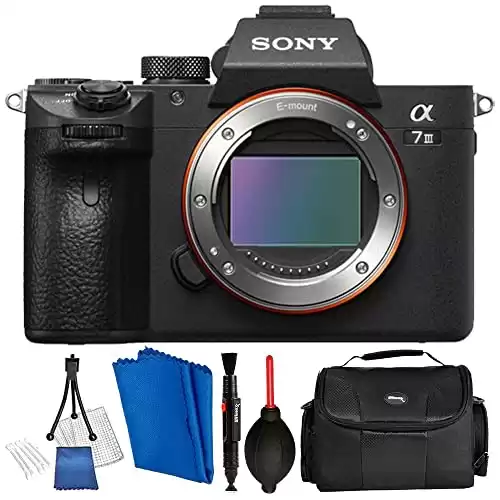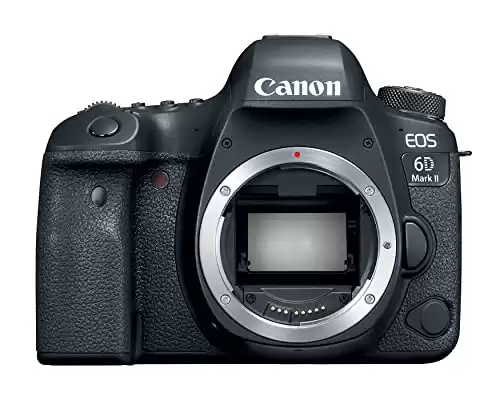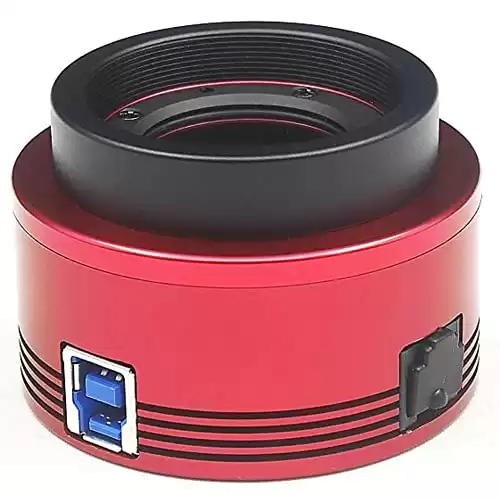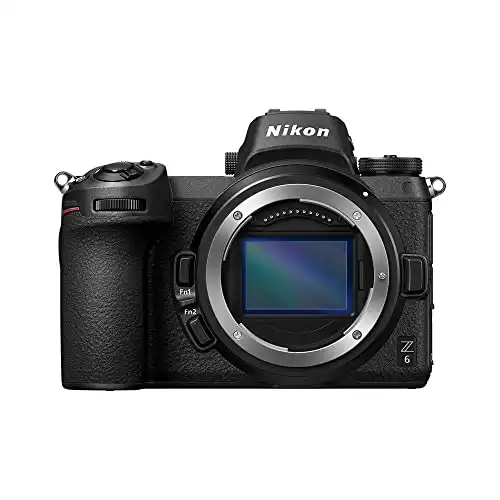| Best for | Product |
|---|---|
| Best Overall | Canon EOS Ra Astrophotography Mirrorless Camera |
| Best DSLR | Nikon D850 FX-Format Digital SLR Camera Body |
| Best Hybrid APS-C | Fujifilm X-T4 Mirrorless Camera Body |
| Best for Low Light Performance | Sony Alpha a7 III Full Frame Mirrorless Digital Camera (Body Only) Bundle Kit |
| Best for Affordability | Canon EOS 6D Mark II Digital SLR Camera Body, Wi-Fi Enabled |
| Best for CMOS Sensor | ZWO ASI183MC 20 Megapixel USB3.0 Color Astronomy Camera |
Have you ever considered shooting for the moon? You have a good chance of landing among the stars if you opt for one of the cameras on this list. Sure, you can take stunning pictures of cityscapes or wild animals in their natural habitat. However, astrophotography is an out-of-this-world genre that you should consider. This is especially true if you often find yourself gazing up at the night sky. Imagine being able to do more than just staring at the night sky- set up your camera for a light painting or time-lapse shot and prepare to be blown away by the results.
Capturing deep sky objects is a delightful experience for every astronomy enthusiast, whether it be through starscapes, close-ups, time-lapse, or light paintings.
As you may have guessed, this long-exposure photography requires more sophisticated imaging than the average genre of photography, especially if your goal is to capture close-up images of celestial bodies.
Once you have the best possible setup, you can go ahead and capture the meteor shower, cosmos, nebulae, and even galaxies. In your search for the right gear, it’s important to know which camera does what. Then, make your choice accordingly.
To take the stress off you, we came up with a list of the best astrophotography cameras you can buy today.
A-Z-Animals’ Top Picks for the Best Astrophotography Cameras You Can Buy Today
#1 Best Overall: Canon EOS Ra Astrophotography Mirrorless Camera
The Canon EOS Ra Astrophotography Mirrorless Camera is our favorite camera for astrophotography. This brilliant camera ticks a lot of boxes for astronomy snappers. Thanks to the modified IR filter on its 30.3MP image sensor, the Canon EOS Ra is able to consolidate the features of the EOS R. This enables four times as many hydrogens 656.3 nm alpha rays and allows for better capturing of the vibrant, deep-red hues we all admire in Astro pictures.
What else does Canon’s first full-frame mirrorless camera offer? It has a whopping 30x zoom in the viewfinder and when shooting in Live View. With this, you can be sure that your starry shots will be as vivid as possible. Most cameras have a maximum magnification of 10, for context.
In addition to having an accurate electronic viewfinder, a vari-angle LCD touchscreen, and Dual Pixel CMOS AF, the Canon EOS Ra can record 4K video at up to 30 frames per second and 4K time-lapse.
An enthusiastic astronomer tried the Astro-modified Canon EOS Ra. In their words, “The first Astro picture I took was with a Tamron 300mm zoom lens and a wide-field refractor telescope. I haven’t been able to get over the result.”
Pros and Cons of the Canon EOS Ra Astrophotography Mirrorless Camera
| Pros | Cons |
|---|---|
| Thanks to its modified IR filter on its 30.3MP image sensor, this mirrorless camera is able to consolidate the features of the EOS R. | None |
| This enables four times as many hydrogens 656.3 nm alpha rays and allows for better capturing of the vibrant, deep-red hues people so admire in astrophotography. | |
| This camera has a 30x zoom in the viewfinder and when shooting in Live View. | |
| Other stellar features include an accurate electronic viewfinder, a vari-angle LCD touchscreen, and Dual Pixel CMOS AF, and the ability to record 4K video at up to 30 frames per second and 4K time-lapse. |
- Features a modified IR filter on its 30.3MP image sensor, which allows the camera to consolidate the features of the EOS R
- The modified IR filter enables 4 times as many hydrogens 656.3 nm alpha rays so you can capture more of the vibrant, deep-red hues that are coveted in astrophotography
- This, Canon's first full-frame mirrorless camera, features a 30x zoom in the viewfinder and when shooting in Live View
- Most cameras have a maximum magnification of 10, so 30x will let you take the most vivid celestial shots possible
- The camera has a wide variety of additional features, including the ability to record 4K video at up to 30 frame per second and 4K time-lapse
2. Best DSLR: Nikon D850 FX-Format Digital SLR Camera Body
Not many DSLRs can hold things down in astrophotography, but the Nikon D850 FX-Format Digital SLR Camera Body proves to be an exception. The back-illuminated 48.7 MP image sensor shoots amazing still pictures while minimizing image noise. Two other benefits of the sensor’s back illumination are better light-gathering ability and low light-performance of the well-controlled ISO range.
The Nikon D850 lacks any astrophotography-related features, but it offers a valuable astro-imaging experience. Its optical viewfinder has a curtain mechanism that blocks stray light during long-exposure photography.
The battery life is enviable to even the best mirrorless cameras, with over 1,000 shots per charge. It can also record 4K UHD videos at 30 frames per second.
A user who does a combination of landscape and astrophotography describes the Nikon D850 as exceptional. “Images from this camera are sharper and have significantly less noise than those from other cameras I’ve used, even when shooting at high ISO settings for nighttime photography.”
While 93% of reviews were positive, there were some negative reviews as well, including one from a user who said that, “The camera had terrible color accuracy and exposure metering.” Another said that their battery died after just 400 shots.
This is by no means a comprehensive list of negative reviews. We recommend that you study the reviews for this and any other camera you may be thinking about purchasing. After all, this is a rather high-end purchase.
Pros and Cons of the Nikon D850 FX-Format Digital SLR Camera Body
| Pros | Cons |
|---|---|
| This DSLR has a back-illuminated 48.7 MP image sensor that shoots amazing still photos while minimizing image noise. | One user said that the camera had terrible color accuracy and exposure metering. |
| The sensor’s back illumination also has better light-gathering ability and low light-performance of the well-controlled ISO range. | Another verified buyer said that their battery died after just 400 shots. |
| This camera lacks any astrophotography-related features, but its optical viewfinder has a curtain mechanism that blocks stray light during long-exposure photography. | |
| The battery life allows you to take an astounding 1,000 shots per charge. | |
| It can record 4K UHD videos at 30 frames per second. |
- This is one of the few DSLRs that's an excellent choice for astrophotography
- It features a back-illuminated 45.7 MP image sensor that shoots stunning stills while minimizing image noise
- The sensor's back illumination also provides better light-gathering ability and low-light performance of the well-controlled ISO range
- Its optical viewfinder features a curtain mechanism that blocks stray light during long-exposure photography
- The battery life is also exceptional, allowing over 1,000 shots per charge
3. Best Hybrid APS-C: Fujifilm X-T4 Mirrorless Camera Body
In a world full of cameras, the Fujifilm X-T4 Mirrorless Camera Body is a class of its own. Designed as a follow-up on the already excellent X T-3, this camera is the latest addition to Fujifilm’s flagship X-T series.
Although it uses the same 26.1MP APS-C sensor as the X-T3, this camera produces excellent image quality. It’s also compatible with a wide variety of lenses. Depending on the frame rate, Cinema 4K videos can be up to 400Mpbs and 60fps. This camera is a top choice for your time-lapse astro videos.
Given that the camera will be pointed at the sky, the vari-angle screen makes shooting much more comfortable than it would be without it. While the 6.5 stops in-body image stabilization system may not be very useful if you’re using a tripod, the body-mounted controls on the camera make it easier to use in low light.
With its excellent low-light performance, robust shutter, and battery life of 500 shots per charge in normal mode, this camera is a viable option for use with other types of photography, such as sports and travel photography. One user bought the Fujifilm X-4 for videography. After using it for a couple of weeks, she commented on the performance. “It fared better than I had expected. Although I mostly use it for videos, I’ve become more interested in photography.”
An amazing 96% of reviews for this product were positive. Negative reviews included a comment from a verified buyer who said, “The unit will freeze and the only way to recover is to remove the battery to reboot the system. Frequently the reboot requires multiple start overs to get it going again.” Another reviewer reported that there was “dirt on the sensor” when they received the camera.
Pros and Cons of the Fujifilm X-T4 Mirrorless Camera Body
| Pros | Cons |
|---|---|
| This mirrorless camera body is the latest addition to the Fujifilm flagship X-T series. | “The unit will freeze and the only way to recover is to remove the battery to reboot the system. Frequently the reboot requires multiple start overs to get it going again.” |
| Although it uses the same 26.1MP APS-C sensor as the X-T3, this camera produces excellent image quality. | Another reviewer reported that there was “dirt on the sensor” when they received the camera. |
| It’s compatible with a wide variety of lenses. | |
| Depending on the frame rate, Cinema 4K videos can be up to 400Mpbs and 60fps, making it ideal for time-lapse astro videos. | |
| The vari-angle screen makes shooting makes shooting the night sky comfortable. | |
| While the 6.5 stops in-body image stabilization system may not be very useful if you’re using a tripod, the body-mounted controls on the camera make it easier to use in low light. | |
| Other features include excellent low-light performance, robust shutter, and battery life of 500 shots per charge in normal mode, making it a great camera for other types of photography as well. |
- Produces excellent quality images
- Compatible with a wide variety of lenses
- Excels at time-lapse astro videos
- Features a vari-angle screen so you can more comfortably capture shots of the sky
- This camera can also be used for travel, wildlife, and sports photography
- It has excellent low-light performance, a robust shutter, and a battery life of 500 shots per charge
4. Best for Low Light Performance: Sony Alpha a7 III Full Frame Mirrorless Digital Camera (Body Only) ILCE7M3/B – Bundle Kit
It’s hard to miss your shot when you use the outstanding Sony Alpha a7 III Full Frame Mirrorless Digital Camera to take stunning pictures of the Milky Way or the moon-lit night sky.
With 24.2MP of resolution, a back-illuminated 35mm full-frame CMOS sensor, and ISO range of 51200, this Sony full-frame mirrorless camera offers you a variety of options in low light and manages image noise.
As further proof that the Sony Alpha 7 III is one of the best suited for astrophotography and videography, the camera has a 3″ tilting touchscreen, which is helpful for shooting from low angles, and it is compatible with Sony E-mount lenses. The electronic viewfinder also offers an exposure-ramped view to help with composing deep-sky images.
Having bought the Sony Alpha 7 III based on a friend’s review, a user had this to say. “I’m glad my 100-400mm lens is compatible with this camera. Not to mention the image/ video quality in low light conditions.”
While the majority of reviews for this product are positive, there are a couple of very concerning negative reviews having to do with the legitimacy of the products: “Sold me a used camera with a fake serial,” and “Sells grey market items, OEM warranty is void. Then they sell you their warranty which is worthless.” We recommend that you read reviews carefully for this and other big-ticket items.
Pros and Cons of the Sony Alpha a7 III Full Frame Mirrorless Digital Camera (Body Only) ILCE7M3/B – Bundle Kit
| Pros | Cons |
|---|---|
| This Sony full-frame mirrorless camera features 24.2MP of resolution, a back-illuminated 35mm full-frame CMOS sensor, and ISO range of 51200, so you’ll have plenty of options in low light and choices when it comes to managing image noise. | “Sold me a used camera with a fake serial.” |
| The camera is ideally suited for astrophotography and videography, with a 3″ tilting touchscreen, which is helpful for shooting from low angles. | “Sells grey market items, OEM warranty is void. Then they sell you their warranty which is worthless.” |
| It’s compatible with Sony E-mount lenses. | |
| The electronic viewfinder offers an exposure-ramped view to help with composing deep-sky images. |
- This full-frame mirrorless camera features 24.2MP resolution and a back-illuminated 35mm full-frame CMOS sensor
- Its ISO range is 51200
- This camera offers ou a variety of low-light options and manages image noise
- Features a 3-inch tilting touchscreen, which is useful when shooting the sky
- This listing is for a bundle kit including the body only
5. Best for Affordability: Canon EOS 6D Mark II Digital SLR Camera Body, Wi-Fi Enabled
As an enthusiastic astrophotographer, you might get to a point where you’re budget-conscious, but also want to access a full-frame system like the Canon EOS 6D Mark II Digital SLR Camera Body, Wi-Fi Enabled.
Whether you prefer to take still images of the deep sky or moving photos, this camera features a rear vari-angle touchscreen display and 4k time-lapse capability. With the former, you can compose astrophotos with crisper angles while the latter is best suited for capturing beautiful videos of the night sky.
While the Canon EOS 6D Mark II only records regular videos at full-HD 1080p, 60FPS, the Live View function does a good job. Also, it has an expandable ISO of 102400 and 26.2MP.
Low-light performance is good for astrophotography. This camera’s fast operation and impressively quiet shutter make it a good fit for entry-level night photographers.
According to one user, they upgraded from a crop sensor to a full-frame sensor on the Canon EOS 6D Mark II because it’s the best DSLR camera for the money.
While 94% of reviews for this camera were positive, there were some negative reviews. One reviewer reported that they’ve had to send theirs in for repairs three times. Another said that their camera shuts off automatically. Yet another said that theirs freezes constantly.
Pros and Cons of the Canon EOS 6D Mark II Digital SLR Camera Body, Wi-Fi Enabled
| Pros | Cons |
|---|---|
| The Canon EOS 6D Mark II Digital SLR Camera Body, Wi-Fi Enabled is an affordable full-frame system. | One reviewer reported that they’ve had to send theirs in for repairs three times. |
| It’s ideal for taking still images of the deep sky or videos, with a rear vari-angle touchscreen display and 4k time-lapse capability. | Another said that their camera shuts off automatically. |
| While this camera only records regular videos at full-HD 1080p, 60FPS, the Live View function does a good job. | Yet another said that theirs freezes constantly. |
| It has an expandable ISO of 102400 and 26.2MP. | |
| It’s low-light performance makes it a good camera for astrophotography. | |
| It’s fast operation and quiet shutter make it perfect for entry-level night photographers. |
- Features a rear vari-angle touchscreen display so you can take astrophotos with crisper angles
- Its 4k time-lapse capability lets you capture picturesque photos of the night sky
- It has an expandable ISO of 102400 and 26.2MP
- Entry-level night photographers will appreciate its low-light performance and the camera's fast operation
6. Best for CMOS Sensor: ZWO ASI183MC 20 Megapixel USB3.0 Color Astronomy Camera
If you’re looking for a relatively portable camera that is suitable for deep-sky photography, then look no further than the ZWO ASI183MC 20 Megapixel USB3.0 Color Astronomy Camera. This camera offers one of the best astrophotography experiences, with the 1.6e read noise, 84% Quantum Efficiency (QE) peak, 20.18MP, and 12 stops of dynamic range. A high QE indicates that more light entering your telescope and reaching the sensor is actually used.
Unlike the ASI183, this camera has color, but it doesn’t have active cooling. The lack of a cooling system makes it relatively lighter than other astro cameras.
No doubt, the ZWO Optical ASI183MC is the perfect camera for solar or lunar imaging because it captures images at a maximum frame rate of 19FPS at full resolution.
The high-speed readout can be used for a variety of astronomic tasks, including real-time focusing, planetary imaging, and lucky imaging of double stars.
The ZWO ASI183MC does “a great job as a planetary camera and the price point is just fine,” a user said.
Ninety-two percent of reviews for this camera were positive. Negative reviews were unavailable on Amazon, so we recommend that you do more research before purchasing this camera.
Pros and Cons of the ZWO ASI183MC 20 Megapixel USB3.0 Color Astronomy Camera
| Pros | Cons |
|---|---|
| This relatively portable camera is suitable for deep-sky photography. | Negative reviews were unavailable on Amazon, so we recommend that you do more research before purchasing this camera. |
| This camera offers This camera offers one of the best astrophotography experiences, with the 1.6e read noise, 84% Quantum Efficiency (QE) peak, 20.18MP, and 12 stops of dynamic range. | |
| It has color, but it doesn’t have active cooling; this makes it relatively light compared to other astro cameras. | |
| It’s ideal for solar or lunar imaging since it captures images at a maximum frame rate of 19FPS at full resolution. | |
| The high-speed readout can be used for a variety of astronomic tasks, including real-time focusing, planetary imaging, and lucky imaging of double stars. |
- This relatively portable camera is designed for deep-sky photography
- It features a wide variety of features, including 1.6e read noise, 84% Quantum Efficiency (QE) peak, 20.18MP, and 12 stops of dynamic range
- This camera has color, but it does not have active cooling. This lack of a cooling system is what makes it lighter than other astro-cameras
- This camera captures solar and lunar images at a maximum frame rate of 19FPS at full resolution
- Because of the high-speed readout, this camera can be used for real-time focusing, planetary imaging, and more
7. Best Mirrorless: Nikon Z6 Full Frame Mirrorless Camera Body
You’re probably wondering “Why Nikon Z6 Full Frame Mirrorless Camera Body when there are Z6 I and II?” In our view, the superior models in the Z6 series aren’t worth the extra money unless you’re using them for videos or wedding photoshoots.
The lower resolution is advantageous for astrophotography because it produces less image noise. When you combine its optimal speed, low light, and resolution with the ISO range of 100-516,200, you’re guaranteed stunning results even in the most challenging lighting conditions. The Nikon Z6’s 24.5MP backlit sensor is also perfect for shooting astro.
“Based on the output, this camera is excellent for low-light astro work,” a user said of the Nikon Z6.
Some of the negative reviews for this camera included, “Less than stellar battery life,” “The battery charger didn’t work,” and “No flip-around screen for selfies or vlogging.”
Pros and Cons of the Nikon Z6 Full Frame Mirrorless Camera Body
| Pros | Cons |
|---|---|
| We think this is the best camera in the Nikon Z6 series for astrophotography. | One reviewer reported that it had a less than stellar battery life. |
| It’s lower resolution is ideal for astrophotography because it produces less image noise. | One verified buyer’s battery charger didn’t work. |
| It’s optimal speed, low light, and resolution with the ISO range of 100-516,2000 guarantee stunning results even in the most challenging lighting conditions. | Another reviewer was displeased because the camera doesn’t have a flip-around screen for selfies or vlogging. |
| The camera’s backlit sensor is also perfect for shooting astro. |
Choosing the Best: What to Look For
ISO range
It’s important to set an ISO that will strike a balance between the amount of light captured and the amount of noise produced because astrophotography typically involves shooting in low light at night.
Lens
Astrophotography is beyond buying the appropriate camera. Lenses have a significant impact on the final output of your images. It is ideal to use fast lenses with large apertures. You should check for compatibility because not all camera models can accommodate the entire range of lenses.
Budget
By now, you’ve realized that astrophotography requires investment in top-notch equipment to get the best results. However, there are still options that can be used by budget-conscious photographers, especially those at the entry level. Always consider your budget when looking for the ideal Astro camera.
 Check Amazon
Check Amazon- Features a modified IR filter on its 30.3MP image sensor, which allows the camera to consolidate the features of the EOS R
- The modified IR filter enables 4 times as many hydrogens 656.3 nm alpha rays so you can capture more of the vibrant, deep-red hues that are coveted in astrophotography
- This, Canon's first full-frame mirrorless camera, features a 30x zoom in the viewfinder and when shooting in Live View
- Most cameras have a maximum magnification of 10, so 30x will let you take the most vivid celestial shots possible
- The camera has a wide variety of additional features, including the ability to record 4K video at up to 30 frame per second and 4K time-lapse
 Check Amazon
Check Amazon- This is one of the few DSLRs that's an excellent choice for astrophotography
- It features a back-illuminated 45.7 MP image sensor that shoots stunning stills while minimizing image noise
- The sensor's back illumination also provides better light-gathering ability and low-light performance of the well-controlled ISO range
- Its optical viewfinder features a curtain mechanism that blocks stray light during long-exposure photography
- The battery life is also exceptional, allowing over 1,000 shots per charge
 Check Amazon
Check Amazon- Produces excellent quality images
- Compatible with a wide variety of lenses
- Excels at time-lapse astro videos
- Features a vari-angle screen so you can more comfortably capture shots of the sky
- This camera can also be used for travel, wildlife, and sports photography
- It has excellent low-light performance, a robust shutter, and a battery life of 500 shots per charge
 Check Amazon
Check Amazon- This full-frame mirrorless camera features 24.2MP resolution and a back-illuminated 35mm full-frame CMOS sensor
- Its ISO range is 51200
- This camera offers ou a variety of low-light options and manages image noise
- Features a 3-inch tilting touchscreen, which is useful when shooting the sky
- This listing is for a bundle kit including the body only
 Check Amazon
Check Amazon- Features a rear vari-angle touchscreen display so you can take astrophotos with crisper angles
- Its 4k time-lapse capability lets you capture picturesque photos of the night sky
- It has an expandable ISO of 102400 and 26.2MP
- Entry-level night photographers will appreciate its low-light performance and the camera's fast operation
 Check Amazon
Check Amazon- This relatively portable camera is designed for deep-sky photography
- It features a wide variety of features, including 1.6e read noise, 84% Quantum Efficiency (QE) peak, 20.18MP, and 12 stops of dynamic range
- This camera has color, but it does not have active cooling. This lack of a cooling system is what makes it lighter than other astro-cameras
- This camera captures solar and lunar images at a maximum frame rate of 19FPS at full resolution
- Because of the high-speed readout, this camera can be used for real-time focusing, planetary imaging, and more
 Check Amazon
Check Amazon- This camera's lower resolution is perfect for astrophotography because it produces less image noise
- Its ISO range is 100 - 516,200
- It features a backlit sensor that's ideal for shooting astro
| Best for | Product |
|---|---|
| Best Overall | Canon EOS Ra Astrophotography Mirrorless Camera |
| Best DSLR | Nikon D850 FX-Format Digital SLR Camera Body |
| Best Hybrid APS-C | Fujifilm X-T4 Mirrorless Camera Body |
| Best for Low Light Performance | Sony Alpha a7 III Full Frame Mirrorless Digital Camera (Body Only) Bundle Kit |
| Best for Affordability | Canon EOS 6D Mark II Digital SLR Camera Body, Wi-Fi Enabled |
| Best for CMOS Sensor | ZWO ASI183MC 20 Megapixel USB3.0 Color Astronomy Camera |
7 Best Astrophotography Cameras You Can Buy Right Now FAQs (Frequently Asked Questions)
What do I need for astrophotography?
How difficult is astrophotography?
What is astrophotography used for?
Besides being able to record the details of extended objects such as the moon, sun, and planets, modern astrophotography has the ability to image objects invisible to the human eye such as dim stars, nebulae, and galaxies.
Thank you for reading! Have some feedback for us? Contact the AZ Animals editorial team.




